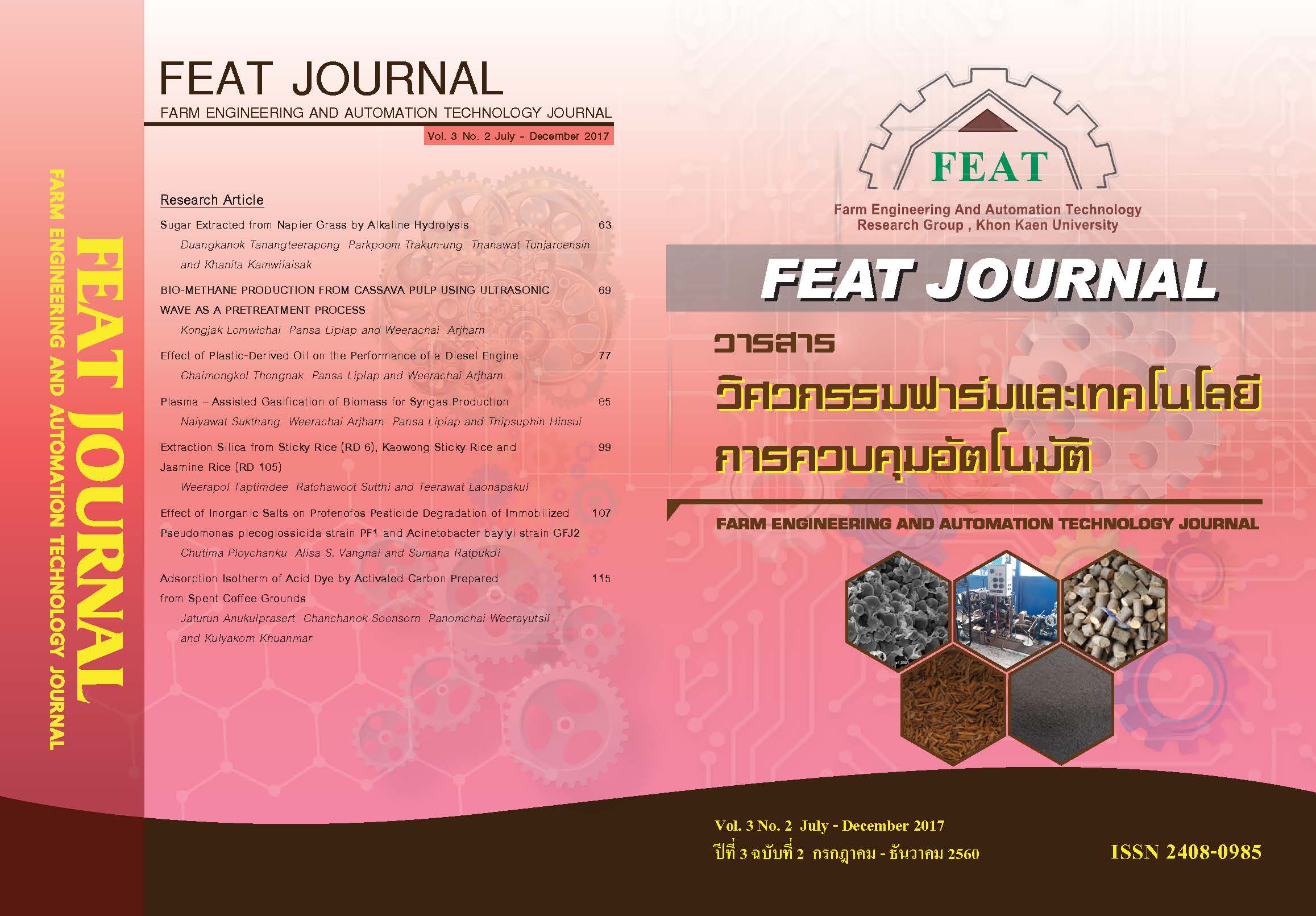ไอโซเทิร์มการดูดซับสีแอซิดโดยถ่านกัมมันต์ที่เตรียมจากกากกาแฟ
Main Article Content
บทคัดย่อ
โครงงานนี้มีวัตถุประสงค์เพื่อศึกษาการดูดซับสีแอซิดด้วยถ่านกัมมันต์จากกากกาแฟที่กระตุ้นด้วยโซเดียมคลอไรด์ (NaCl) นอกจากนี้ได้ศึกษาระยะเวลาที่เข้าสู่สมดุลของการดูดซับและได้ทำการศึกษาไอโซเทิร์มของการดูดซับโดยใช้ตัวดูดซับ 2 ชนิดคือ ถ่านจากกากกาแฟ และถ่านกัมมันต์จากกากกาแฟ การทดลองทั้งหมดจะทำการทดสอบการดูดซับสารละลายสีแอซิดสีแดง ในการเตรียมถ่านกัมมันต์จากกากกาแฟ กากกาแฟแห้งจะถูกเผาที่ 600 องศาเซลเซียส เพื่อให้ได้ถ่านกากกาแฟ และหลังจากนั้นถ่านกากกาแฟจะถูกกระตุ้นด้วยสารละลายโซเดียมคลอไรด์ ในอัตราส่วน 1:1 โดยน้ำหนัก แล้วนำไปเผาที่อุณหภูมิ 800 องศาเซลเซียส การศึกษาระยะเวลาที่เข้าสู่สมดุล พบว่าระยะเวลาในการดูดซับที่เข้าสู่สมดุลของถ่านจากกากกาแฟและถ่านกัมมันต์จากกากกาแฟคือ 210 และ 300 นาที ตามลำดับ ค่า pH ของสารละลายสีแอซิดภายหลังการดูดซับด้วยถ่านจากกากกาแฟและถ่านกัมมันต์จากกากกาแฟมีแนวโน้มเพิ่มสูงขึ้น เมื่อศึกษาไอโซเทิร์มของการดูดซับพบว่ารูปแบบการดูดซับสอดคล้องกับแบบฟรุนดิชทั้งถ่านจากกากกาแฟและถ่านกัมมันต์จากกากกาแฟ
Article Details
วารสารวิศวกรรมฟาร์มและเทคโนโลยีควบคุมอัตโนมัติ (FEAT Journal) มีกําหนดออกเป็นราย 6 เดือน คือ มกราคม - มิถุนายน และ กรกฎาคม - ธันวาคม ของทุกปี จัดพิมพ์โดยกลุ่มวิจัยวิศวกรรมฟาร์มและเทคโนโลยีควบคุมอัตโนมัติ คณะวิศวกรรมศาสตร์มหาวิทยาลัยขอนแก่น เพื่อเป็นการส่งเสริมและเผยแพร่ความรู้ ผลงานทางวิชาการ งานวิจัยทางด้านวิศวกรรมศาสตร์และเทคโนโลยีพร้อมทั้งยังจัดส่ง เผยแพร่ตามสถาบันการศึกษาต่างๆ ในประเทศด้วย บทความที่ตีพิมพ์ลงในวารสาร FEAT ทุกบทความนั้นจะต้องผ่านความเห็นชอบจากผู้ทรงคุณวุฒิในสาขาที่เกี่ยวข้องและสงวนสิทธิ์ ตาม พ.ร.บ. ลิขสิทธิ์ พ.ศ. 2535
เอกสารอ้างอิง
[2] Gomez-Gonzalez, R., F. J. Cerino-Cordova, et al. (2016). "Lead biosorption onto coffee grounds: Comparative analysis of several optimization techniques using equilibrium adsorption models and ANN." Journal of the Taiwan Institute of Chemical Engineers 68: 201-210.
[3] Jung, K.-W., B. H. Choi, et al. (2016). Fabrication of granular activated carbons derived from spent coffee grounds by entrapment in calcium alginate beads for adsorption of acid orange 7 and methylene blue. 219: 185-195.
[4] Campos-Vega, R., G. Loarca-Pina, et al. (2015). "Spent coffee grounds: A review on current research and future prospects." Trends in Food Science & Technology 45(1): 24-36.
[5] Lee, J.-W., S.-P. Choi, et al. (2006). "Evaluation of the performance of adsorption and coagulation processes for the maximum removal of reactive dyes." Dyes and Pigments 69(3): 196-203.
[6] Namane, A., A. Mekarzia, et al. (2005). "Determination of the adsorption capacity of activated carbon made from coffee grounds by chemical activation with ZnCl2 and H3PO4." Journal of Hazardous Materials 119(1-3): 189-194.


